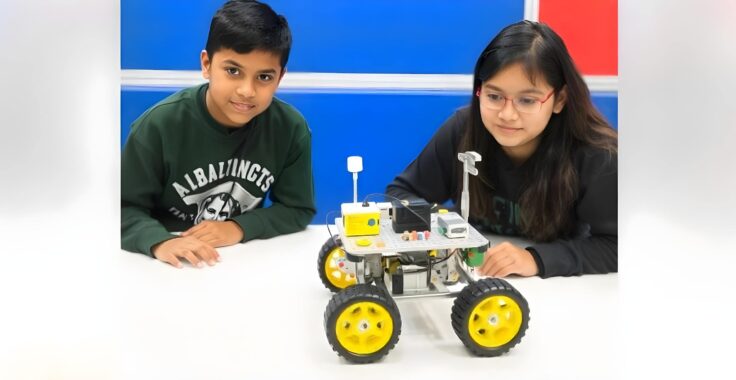
In today’s fast-paced world, it’s becoming increasingly clear that the next generation needs a solid grounding in STEM—Science, Technology, Engineering, and Mathematics. These aren’t just subjects we learn in school; they’re the building blocks for understanding the world around us and solving some of its biggest challenges. But how do we get young learners excited about these sometimes daunting subjects? One of the most effective ways is through something that sparks their imagination: designing and building their own rovers.
Learning by Doing: The Magic of Hands-On Projects
Imagine being a young student and instead of just reading about physics or engineering, you actually get to build a mini-robot—your very own rover. This kind of hands-on project is a powerful way to learn because it takes abstract concepts and turns them into something tangible.
When kids are working on their rovers, they’re not just sitting back and listening; they’re actively engaged. They’re figuring out how gravity affects movement, how different materials can make their rover stronger or faster, and how to measure and cut pieces just right so everything fits together. Suddenly, math and science aren’t just numbers and formulas—they’re tools that help them bring their ideas to life.
Engineering and Technology Come to Life
Rover design isn’t just about following instructions—it’s about thinking like an engineer. Kids are faced with challenges that require them to brainstorm, test, and tweak their designs until they get it right. This process teaches them that failure isn’t the end—it’s just a step on the road to success.
For instance, maybe their first rover doesn’t move as smoothly as they hoped. Why? Maybe the wheels are too small, or the body is too heavy. By experimenting with different solutions, they’re learning basic engineering principles without even realizing it. They might also need to figure out how to power their rover, introducing them to the basics of electrical engineering. It’s real-world problem-solving at its best, and it’s a lot of fun, too.
Inspiring Future Space Explorers
One of the coolest things about rover design is its connection to space exploration. We all know about the amazing rovers that NASA sends to Mars—these are some of the most advanced machines ever built. By working on their own rovers, kids can feel a personal connection to these incredible missions. They start to see themselves as part of something bigger—maybe even as future engineers or scientists who will help explore the stars.
As they design their rovers, kids also learn about the planets and moons these machines might explore. They think about what challenges their rover would face on Mars or the Moon and how they would design it to survive. This blend of creativity and scientific thinking helps them see how STEM fields are interconnected in the real world.
Learning to Work Together
Building a rover isn’t a solo project—it’s something that works best when done as a team. Kids learn to share ideas, divide up tasks, and work together to solve problems. These teamwork skills are incredibly valuable, not just in school but in any career they might choose in the future. Plus, there’s something special about achieving a goal together that makes the experience even more rewarding.
Conclusion
In the end, rover design is much more than just a school project. It’s an opportunity for kids to dive into STEM in a way that’s exciting, hands-on, and deeply meaningful. They’re not just learning—they’re creating, experimenting, and discovering how the world works. By giving young learners the chance to build their own rovers, we’re not just teaching them about science and engineering—we’re helping them build the skills and confidence they’ll need to tackle whatever challenges the future holds. And who knows? Maybe one of these kids will go on to design the next rover that lands on Mars.






hngk06
4jtkok
NzPZLuax kjTE NWprJDqf seeHuJ tIlqO OZZUs
https://myteana.ru/forums/index.php?autocom=gallery&req=si&img=6611
http://terios2.ru/forums/index.php?autocom=gallery&req=si&img=4583
Awesome https://is.gd/tpjNyL
Very good https://is.gd/tpjNyL
Very good https://is.gd/tpjNyL
Awesome https://shorturl.at/2breu
Very good https://shorturl.at/2breu
Good https://lc.cx/xjXBQT
Very good https://lc.cx/xjXBQT
Very good https://lc.cx/xjXBQT
Good https://lc.cx/xjXBQT
Awesome https://lc.cx/xjXBQT
Awesome https://lc.cx/xjXBQT
Awesome https://lc.cx/xjXBQT
Good https://t.ly/tndaA
https://vitz.ru/forums/index.php?autocom=gallery&req=si&img=5015
http://toyota-porte.ru/forums/index.php?autocom=gallery&req=si&img=3371
https://vitz.ru/forums/index.php?autocom=gallery&req=si&img=5046
Макс Барских – Ну И Что (Dj Prezzplay) скачать mp3 и слушать бесплатно https://shorturl.fm/xhQFv
LYRIQ – Она Не Поверит скачать и слушать песню бесплатно https://shorturl.fm/lwBdB
https://shorturl.fm/m0boc
https://shorturl.fm/EY2zu
https://shorturl.fm/XA5ve
https://shorturl.fm/lReBx
https://shorturl.fm/8XB8J
https://shorturl.fm/orq0w
https://shorturl.fm/ua5au
https://shorturl.fm/JwyqX
https://shorturl.fm/YDEvm
https://shorturl.fm/k3ERD
https://shorturl.fm/jXCJn
https://shorturl.fm/cvMxb
https://shorturl.fm/ypbEd
https://shorturl.fm/24mu1
https://shorturl.fm/AAGij
https://shorturl.fm/6OBP1
https://shorturl.fm/g9s1E
https://shorturl.fm/PD6P0
https://t.me/s/TgGo1WIN/3
https://shorturl.fm/qxfJL
https://t.me/s/Webs_1WIN
https://shorturl.fm/7QWE3
https://shorturl.fm/3ifOC
https://shorturl.fm/JfpYg
https://shorturl.fm/yfyQM
https://shorturl.fm/Wwx1D
https://shorturl.fm/KFtcm
https://shorturl.fm/MBzIQ
Официальный Telegram канал 1win Casinо. Казинo и ставки от 1вин. Фриспины, актуальное зеркало официального сайта 1 win. Регистрируйся в ван вин, соверши вход в один вин, получай бонус используя промокод и начните играть на реальные деньги.
https://t.me/s/Official_1win_kanal/1011
https://t.me/s/Official_1win_kanal?before=3246
https://shorturl.fm/7vO5h
https://shorturl.fm/GSKyr
https://shorturl.fm/1luR1
https://shorturl.fm/PKIeC
https://shorturl.fm/zUCLx
https://shorturl.fm/sBukd
https://shorturl.fm/kc2mW
https://shorturl.fm/cDBZ3
https://shorturl.fm/kVowM
https://shorturl.fm/uC7Qf
https://shorturl.fm/RRutS
https://shorturl.fm/IHLc1
https://shorturl.fm/fmIKd
https://shorturl.fm/m5VLT
https://shorturl.fm/O4pEW
https://shorturl.fm/SySjD
https://shorturl.fm/UEkFA
https://shorturl.fm/qxACy
https://shorturl.fm/8Gio9
https://shorturl.fm/wKhby
https://shorturl.fm/EEA7x
https://shorturl.fm/6cSx5
https://shorturl.fm/wL33s
https://shorturl.fm/G8hw8
https://shorturl.fm/5Efp9
https://shorturl.fm/JzQNx
https://shorturl.fm/233We
https://shorturl.fm/nPELj
https://shorturl.fm/3pjr9
https://shorturl.fm/vfXcC
https://shorturl.fm/fpgAa
https://shorturl.fm/DrLtA
https://shorturl.fm/BU5BZ
https://shorturl.fm/qJMnb
https://shorturl.fm/RfvPO
https://shorturl.fm/jtcnG
https://shorturl.fm/EpeT8
https://shorturl.fm/xDzcE
https://shorturl.fm/16PSs
https://shorturl.fm/1tZ33
https://shorturl.fm/pRiWt
https://shorturl.fm/3YfU7
https://shorturl.fm/YivGv
https://shorturl.fm/c6REH
https://shorturl.fm/CtXX5
https://shorturl.fm/Wr3h5
https://shorturl.fm/RfKcn
https://shorturl.fm/2JV4W
https://shorturl.fm/uDHWD
https://shorturl.fm/y2vbs
https://shorturl.fm/oYOXE
https://shorturl.fm/oKOIS
https://shorturl.fm/auopf
https://shorturl.fm/lWpWf
https://shorturl.fm/r4h1x
https://shorturl.fm/Vy8Hj
https://shorturl.fm/A02yb
https://shorturl.fm/4Y3Bg
https://shorturl.fm/rbS4J
https://shorturl.fm/6YLQx
https://shorturl.fm/ec3SU
https://shorturl.fm/7km5a
https://shorturl.fm/u4tnb
https://shorturl.fm/Jk1R4
https://shorturl.fm/n2jfZ
https://shorturl.fm/Ewp7a
https://shorturl.fm/Xwr8r
https://shorturl.fm/Gyx1I
https://shorturl.fm/YtUdT
https://shorturl.fm/847ay
https://shorturl.fm/f3baW
https://shorturl.fm/jibUj
https://shorturl.fm/dnD2D
https://shorturl.fm/NFdLW
https://shorturl.fm/q2dpK
https://shorturl.fm/AuaEP
https://shorturl.fm/vi2pg
https://shorturl.fm/iN5Ue
https://shorturl.fm/D3EAj
https://shorturl.fm/Rt1Sd
https://shorturl.fm/0WRm4
https://shorturl.fm/O7x2g
https://shorturl.fm/iJjbR
https://shorturl.fm/LzzeD
https://shorturl.fm/wPOFZ
https://shorturl.fm/j5hXa
https://shorturl.fm/9intx
https://shorturl.fm/TYaFf
https://shorturl.fm/YH3LT
https://shorturl.fm/gpQ5D
https://shorturl.fm/Bv3Ay
https://shorturl.fm/h1GJN
https://shorturl.fm/3Bgq3
https://shorturl.fm/0D0Ja
https://shorturl.fm/rEz9w
cdrhyb
https://shorturl.fm/znWE2
https://shorturl.fm/psfhu
https://shorturl.fm/uJlvN
https://shorturl.fm/PWT2N
https://shorturl.fm/35YI8
https://shorturl.fm/djOVS
https://shorturl.fm/4C2u1